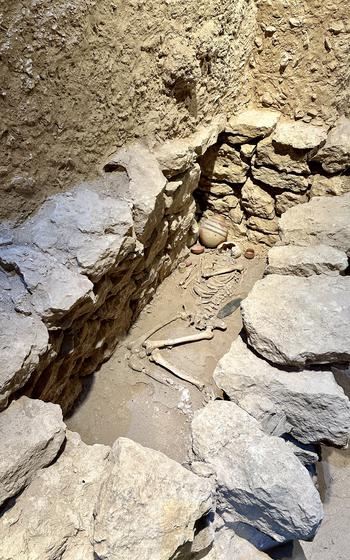
Sculptures made of white travertine line the walkway leading to the Bahrain National Museum in Manama. (Shannon Renfroe/Stars and Stripes)
The Bahrain National Museum in Manama can be easy to miss when driving down the highway. The exit creeps to the right suddenly, so be wary of the sign.
But the museum, marked by stone sculptures of white travertine placed like chess pieces that lead to the entrance, was well worth the trouble of tracking it down. It offers a captivating journey through time and a multifaceted showcase of the country’s story.
One of the museum’s most compelling features is its collection that spans over 6,000 years of the history of what is today Bahrain. The exhibits trace the island nation’s evolution from ancient civilization to its modern, thriving economic hub. The Dilmun civilization, which flourished around 3,000 B.C., is a focal point of the museum’s collection. Known as a center of trade and prosperity, Dilmun is often referenced in ancient Sumerian texts as a land of paradise.
The museum brings this era to life with artifacts such as pottery, seals and tools, providing a tangible connection to the distant past. The re-created burial grounds were a highlight for me, offering a glimpse into the funerary practices of the Dilmun people. Visitors can explore a section showcasing scenes from early Bahraini civilization during its pre-industrial past. Although some mannequins show signs of wear, the costumes and set designs offer an insightful glimpse into life during simpler times. The museum houses six permanent exhibitions, a library and an art gallery, which showcases rotating artists. All upcoming events and artists are on the museum website.
Three of the exhibitions are dedicated to archaeology and the ancient civilization of the Dilmun, while another two depict various cultural scenes and crafts, and the sixth features documents and manuscripts.
I enjoyed walking through the Dilmun burial grounds because it felt as though I was in the desert with the excavators, stumbling across the skeletal remains of a civilization that had been hidden for centuries. I looked down at the skeleton of a 45-year old male that lived around 2000-1900 B.C., imagined the life he had and how carefully his community buried him, ritually laying him on his right side.

The Bahrain National Museum offers a glimpse into the burial practices of the Dilmun civilization, which flourished in about 3,000 B.C. (Shannon Renfroe/Stars and Stripes)
No one spoke as they walked through this exhibition. There was an air of somberness, but also humility and an appreciation for life. The experience was beyond anything I imagined having while visiting a museum.
On a much lighter note: the cafe is a must. I enjoyed a rose lemonade made from scratch, the perfect refreshment for a hot summer day in Bahrain. The Bahrain National Museum is in a beautiful location along the Manama waterfront because it sits adjacent to the Bahrain National Theater, also an architectural treasure. It offers ample parking, so there is one fewer thing to stress about.

The Dilmun civilization, which flourished around 3,000 B.C., is a focal point of the Bahrain National Museum's collection. (Shannon Renfroe/Stars and Stripes)
Stepping into the museum was a welcome break from the sweltering summer heat, but it was also an opportunity to quietly venture through a maze of interesting artifacts.
There isn’t much guidance as to where you should start, other than a large mural of Bahrain that spreads across the entire floor of the museum. Not having maps at every corner eliminated the pressure to fit every exhibition into one visit. It isn’t the Smithsonian, but it’s impressive nonetheless, and left me with a deeper appreciation for Bahrain and the path it has taken.
Bahrain National Museum
Address: Shaikh Hamad Causeway, Manama, Bahrain
Hours: 9 a.m-8 p.m. daily; closed Tuesdays
Cost: Tickets are 1.1 BD (about $3)
Information: Online: tinyurl.com/4ptbt6f5